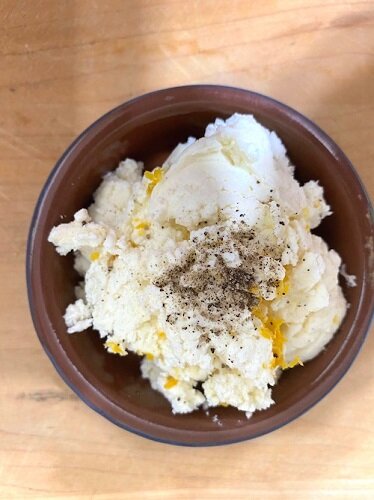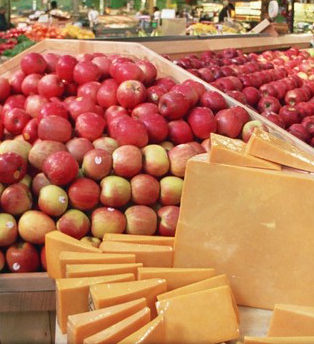8 Surprising Ways to ‘Bridge’ the Cheese & Beverage Divide
A good bridge can connect a mismatched cheese and wine, beer or cider, and it can make a perfect pairing and make it sing.
I was first introduced to bridges when I was working on my California cheese book and a winery chef made grapefruit gelée to complement his pairing of local goat cheese with the winery’s sauvignon blanc. The beautiful little fruit squares enhanced the tanginess of the cheese and made the wine’s citrus aromas pop.
But you don’t need to go to culinary school to create a perfect bridge for your cheese and wine pairings. Here are eight easy tips to build better bridges between your cheese and wine.
1. Pepper and lemon: the universal bridge for all wines
Sheana Davis, chef, cheesemaker, caterer, and owner of The Epicurean Connection in Sonoma, California, says her best trick for bridging is sprinkling black pepper and lemon zest over fresh cheese. “This is one of my favorite bridges,” she says. “It’s one of my go-to’s when I’m on the road because I can always find a fresh cheese, some black pepper and some lemons. But I started doing this when we would have a catering job, and the winemaker wanted to feature both his red and white wines, but he can only afford one cheese.” The pairing works with any and all fresh cheeses – chevre, fresh sheep’s milk, ricotta, mozzarella, fromage blanc, burrata – you name it, if it’s fresh, it will work. And it works for almost any kind of wine. “This works for red wines, white wines and even rosé wines,” Davis says. “It’s simple, and people go gaga over it.”
2. Dark honey and red wine
Jaclyn Stuart, certified sommelier and owner of Vintage Elkhart Lake, a wine store in Elkhart Lake, Wisconsin, says she’s “gotten nerdy” over different honeys. “There really are different profiles of honey,” Stuart says. “Dark honeys go really well with some red blends that have a little residual sugar in them, but they’re not sweet. If you add that darker honey to a cheese board, it adds this fun dimension.” Actual honey comb can also be used. “It makes a presentation that is attention grabbing, and it makes an impact,” she says.
3. Banana and bleu and sweet wine
Charles Duque, managing director of the Americas for the French Dairy Board, recommends placing a bit of bleu (or blue) cheese on a cracker, then topping it with a slice of banana before pairing the cheese with a sweet dessert wine. “This is a trick I learned from a maître fromager,” he says. “The ripe banana is creamy and sweet, the creamy blue cheese is salty, the cracker is crunchy and there’s an equilibrium, and there’s this wonderful mouthfeel.” Duque says this is akin to placing an aged slice of Roquefort on a baguette with butter. “The butter balances out the saltiness and that pungency,” he says.
"whole foods cheese and apples" by cafemama is licensed under CC BY-NC-SA 2.0
4. Apples with beer and cider
Fruit is probably the most traditional accompaniment to a cheese and wine pairing, and almost any fruit works…except for apples. “Apples will make your wine taste flat,” Stuart says. “It actually takes a way Fruit is a traditional accompaniment to wine and cheese, and basically any fruit works, except for apples. “Apples will make the wine taste flat,” Stuart says. “Apples actually take away the acidity and the tannin profiles of a wine. Eat a bite of apple, and then take a big sip of wine…the wine will be really dull. Apples, however, do make great bridges for pairing cheese with ciders and beers, Stuart points out.
5. Dried fruits and nuts with wine
Stuart and Davis both recommend dry fruits especially. Apricots, Stuart says, go with Rieslings, some sauvignon blancs, and sauternes and late harvest wines. Mangoes go great with viogniers and gewurztraminers. Dried cherries and currants go with red wines, and dried cranberries are especially good with a Pinot Noir. Dark cherries, combined with blue cheese and just a grating of dark chocolate, can become nirvana when paired with red wines, Davis says. “I’m not usually a fan of wine and chocolate, but if you put the right combination together, it’s a really good mouthfeel,” Davis says. The secret, Davis says, is to grate the chocolate right onto the cheese, rather than to put chunks or chips onto the cheese. Grated dark chocolate, dried cherries and port wine is simply divine, she says. And if you want to get fancy, put the three ingredients together in a puff pastry.
Nuts are also great bridges, and Davis especially recommends adding pecans to any cheese you’re pairing with a Cabernet Sauvignon. “Cabernet has an earthy, almost nutty finish, and you add the nut with the cheese, and it blends them all together perfectly,” Davis says.
herbs and spices
6. Cocoa, spices and herbs with red wine
Just like Davis grates chocolate onto the cheese, Stuart rolls blue cheese wedges into cocoa powder to pair with port. “It basically adds another level of complexity and intensity to the pairing,” Stuart says. But cocoa powder isn’t the only thing Stuart likes to roll her cheese wedges into. She uses fresh and dried herbs and spices – herbes de provence, dill, paprika. “Any of these things can add this little pop of flavor and color,” Stuart says. Paprika, especially smoked paprika, can bridge milder cheeses with red wines. “Really rich, red wines will overpower the vast majority of cheeses,” Stuart says. “What I do is I take the spice or herb, and sprinkle a small amount on a plate, then I roll the edge of the cheese through it,” adding “A lot of cheesemakers do herb-rind cheeses, and they’ve already done the bridge for you, the whole Bellavitano line are cheeses with a bridge.”
mustard and cheese
7. Mustard with wines
Stuart loves mustard and pretzels, but not just for when she’s enjoying a beer. Mustards actually pair really well with pinot noir and chardonnay, and they go great with cheddars and goudas. She especially enjoys East Shore Foods Mustards for Cheese – Mustard for Cheese Stone Ground and Mustard for Cheese Sweet and Hot. “Mustards add some tanginess and some sweetness that perks up and enriches the flavor profiles of mild to medium cheeses, and it helps them stand up to an Oakey chardonnay or a more complex pinot noir,” Stuart says. “It just tightens up that pairing and adds more to it.”
8. Seedy, nutty, or spicy bread or crackers and wine
Choosing a bread or a cracker with seeds, nuts, spices, herbs or fruits can enhance a pairing, both Stuart and Davis say. “I’m a huge fan of walnut bread, pumpkin seed bread,” Davis says. “It can completely change a pairing.” Toasted seeds in crackers or breads can pair up with the oaky aromas of aged wines, Stuart says. Rosemary can also brighten up a pairing, too, she says. “Even just picking the right cracker that isn’t neutral can make a nice bridge,” Stuart says. “An herbal cracker can pair with a nice, herbaceous wine. It makes the pairing multi-dimensional.”









